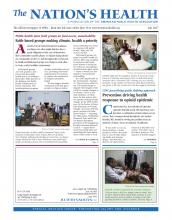It is a tale as old as cars themselves: For as long as people have been driving, there have been motor vehicle injuries.
“The things that have killed us for decades are killing us still: alcohol, speed, distractions and seat belts — or lack thereof,” said Deborah Hersman, MS, president and CEO of the National Safety Council. “Motor vehicle crashes in the U.S. are accepted as the cost of mobility by society, but the cultural Novocain must wear off, because more than 100 people each day are dying in crashes we know how to prevent.”
The Centers for Disease Control and Prevention has prioritized traffic safety for drivers, passengers and pedestrians, and offers data and tools, including seven Vital Signs reports on the topic since 2011, on its motor vehicle safety webpage. There, the latest statistics, as well as case studies from different states and communities, are available for public health leaders to use and apply to their own communities.
Motor vehicle safety is more important than ever before, as traffic deaths are ticking up: Hersman said the National Safety Council estimates that up to 40,000 people died in car crashes last year — a 6 percent jump from 2015 and a 14 percent increase since 2014, the steepest two-year climb in more than 50 years.

Protective child safety seats, and their proper use, can save lives in the event of a traffic crash. Communities and states are taking steps to improve traffic safety, but risks still remain.
Photo by Antonio_Diaz, courtesy iStockphoto
U.S. traffic fatality statistics were already high before the recent increase: A 2016 CDC Vital Signs report noted that in 2013, the American crash death rate was more than twice the average of other high-income countries, and front-seat seat belt use was lower than in other comparison countries. A third of U.S. crashes involved drunken driving, and nearly that many involved speeding, according to the report. That translates to $44 billion in medical expenses and work loss costs each year.
But there is some cause for hope. Winnable Battles, released March 30 by CDC, outlines trends and progress made on several key public health fronts, including motor vehicle injuries. The report notes that even with the recent increases, motor vehicle deaths in the U.S. have decreased by 15 percent since the mid 2000s. The U.S. is getting closer to CDC targets as well, with 2015 showing a fatality rate of 11 per 100,000, just a little higher than the CDC’s goal of 9.5 per 100,000.
The report notes that a few key strategies can have major effects on improving safety on the road. It referenced multiple CDC reports, including the “State-Specific Fact Sheets on Cost of Motor Vehicle Crash Deaths, Restraint Use and Drunk Driving;” Prevention Status Reports, which highlight policies and practices touching on public health issues, including motor vehicle safety; and Parents are the Key, a campaign that offers parents, pediatricians and communities information and tools to promote safe teen driving.
Utilizing the tools available from CDC can help communities enact small policy shifts with big impacts. For example, Hersman highlighted the Mark Wandall Traffic Safety Program Act, a 2010 Florida law authorizing red light cameras. Once the law was passed and cameras were installed, she said, red light-running fatalities in the state decreased by 24 percent between 2011 and 2015.

Seat belt use hovers at about 90 percent nationally. Programs that are highly publicized can make a major difference.
Photo by Minerva Studio, courtesy iStockphoto
High-visibility campaigns also make a lasting impact: Hersman noted that the community awareness surrounding the Phone in One Hand, Ticket in the Other campaigns in New York and Connecticut in 2010, which were partnerships with the National Highway Traffic Safety Administration, showed a significant drop in driver cellphone use, by as much as a 72 percent reduction in texting, and a 57 percent drop in handheld phone use in Hartford, Connecticut.
But risks remain, particularly for American Indian and Alaska Native communities. Motor vehicle crashes are the leading cause of unintentional injuries among this racial group for people ages 1 to 44, and American Indians and Alaska Natives are 1.5 times more likely to die in a crash than whites or blacks, according to CDC data.
Thus, CDC has issued its “Tribal Motor Vehicle Injury Prevention Best Practices Guide 2016.” Highlighting what works to prevent motor vehicle crash injury and death, as well as federal, tribal and state responses and components for effective prevention, the report includes success stories and tips for communities.
That is particularly important for communities with limited resources or data, said Adam Larsen, a safety engineer with the U.S. Department of Transportation’s Tribal Transportation Program. The program offers structural and financial assistance directly to tribal communities working to improve motor vehicle safety locally.
Many tribal communities have lower rates of seat belt use than national averages, according to CDC data. While overall seat belt usage hovers around 90 percent, in 2016, among 17 surveyed reservation communities, some had rates as low as 49 percent, CDC reported.
Local communities partnering with CDC and Tribal Transportation Program are leading the way to improve community safety. In one example, the Hopi Tribe in Arizona has used CDC funding to strengthen existing seat belt laws through collaboration with local law enforcement. CDC reported that an accompanying education campaign helped raise seat belt use from 39 percent to 53 percent, and increase child safety seat use from 22 percent to 29 percent.
Larsen noted that the Lummi Nation in Washington has done a particularly good job of using partnerships to build strategic plans, improve data capabilities and implement “some really good projects,” including adding roundabouts on reservation roads and promoting pedestrian safety.
A 2016 Lummi Nation Road Safety Audit Report by Eastern Washington University touted the implementation of the Lummi Nation Haxton Way Pedestrian Path/Lighting Project. In March, solar lighting company Sol noted that Haxton Way previously had the highest traffic fatality rate of any road on the reservation, as high speeds and a lack of pedestrian space converged there. The creation of a three-mile trail, with environmentally sustainable lighting, made the area both more accessible and safe to pedestrians.
Building partnerships is key, Larsen said, because tribal communities, particularly in rural areas, may lack the resources of other communities. In a National Congress of American Indians and Leadership Conference Education Fund policy brief, experts noted that reservation roads are still the most underdeveloped road network in the U.S. despite being the principal transportation system for all residents of and visitors to tribal communities. The brief also noted that American Indian people are twice as likely as all other ethnic groups in the United States to die as a result of motor vehicle crashes.
“You just don’t have the same quality of infrastructure in tribal areas,” Larsen told The Nation’s Health. ”There’s a lot of data that goes unreported. Standing Rock (Sioux Tribe in North and South Dakota) has a good safety data improvement program going on. Their law enforcement uses narrative crash reports instead of putting crash data in a format they can use for safety planning, but they see the data as so important that they’re… hand-coding it. It’s not an ideal situation, but they’re doing the best they can with what they have.”
It is motivation such as at Standing Rock, valuing traffic safety, that will make a difference in communities across the country, Hersman said. She said acknowledging motor vehicle deaths and injury as a public health crisis is the first step in addressing the issue.
“If a plane crashed every single day, killing 100 people, we would ground air traffic, hold congressional hearings and demand change,” Hersman told The Nation’s Health. “We need to be equally as outraged when it comes to motor vehicle crashes. One hundred lives a day is unacceptable.”
With data and tools readily available from CDC, communities can dig into the information to find solutions that will work. Both CDC data and Hersman call for collaboration, such as Road to Zero Coalition, an initiative started in 2016 with the Department of Transportation that comprises more than 250 organizations and individuals committed to ending roadway deaths in the next 30 years.
“It may seem like an impossible goal, but we have seen the public health community accomplish seemingly impossible things, like eradicating certain diseases and changing attitudes about smoking,” Hersman said. “Getting to zero deaths on our roadways will take all of us. It won’t be easy, but it will have a tremendous impact on those injured on our roadways as well as the families of those killed.”
To learn more, visit www.cdc.gov/motorvehiclesafety.
- Copyright The Nation’s Health, American Public Health Association












